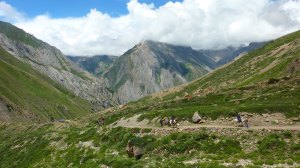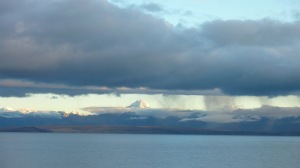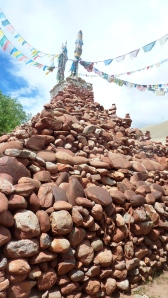Kailash and Mansarovar revisited!
Travel is a genre that I am partial to. Having enjoyed Mark Shand’s earlier book on his elephant adventure (Travels on my elephant) through Eastern India, I recently picked up his “River Dog”. I was attracted by the blurb which said that it was on a journey down the Brahmaputra. I only vaguely remember the content, but not the style of writing of the earlier book. However, I do remember that the protagonist was the elephant and should not have been surprised that the book was so dog – centric!! He recounts his trip from the point where the river enters Arunachal Pradesh to its final gush into the Bay of Bengal, large parts of it on boats. The complexities of the travel permits, the encounters with the bureaucracy, the intricacies of the India-Bangladesh border, its porosity and complexity were interesting aspects. There were also interesting references to the legendary British explorers of the past, especially in relation to the original tracing of the source and route of this magnificent river through Tibet. The book has an easy to read style, but is a bit too casual and dwells too much on Shand’s own antics.
But the surprise element and the best part of the book for me was his trip to TIbet, with Charles Allen, another great adventurer/traveller/writer. Shand’s dream was to travel the full route of the Brahmaputra and since more that half its course runs in Tibet, he accepts Allen’s invitation to join an expedition in search of Shagri-La in TIbet. He believs that this would give him some tips to plan his own trip through this generally hostile terrain. So when I read this – “A panorama unfolded in front of me of such beauty that it would have taken my breath away ….. Behind me lay the great white necklace of the Gurla Mandata massif. To my right, just a few steps in fact, lay Mansarovar, or Mapham Tso, the ‘turquoise lake’ – a sphere of sapphire so bright, so blue, so enticing that I felt I could pick it and hold it in my hand.” – the words transported me to the moment just over a year ago, when I too had felt the awe and wonder of this most sacred of places in the world. I felt that if I had written a book on my trip to Kailash- Mansarovar, my words may have been almost identical. “To the north, over the far horizon directly in front of me, soaring above a range of desolate, brown and wind-blasted hills, was the crown jewel: Kailash, a perfect come of ice, the holiest of all mountains, the axis of the universe, the navel of the world. Most of us have experienced a moment in our lives when we are humbled by the sheer power and beauty of nature. But Kailash blew my mind. I was rooted to the spot – hypnotised. I’m not really a religious person, but i could well understand why devotees for thousands of years had prostrated themselves in awe on their first glimpse of the mountain. It was impossible not to believe that if there was a god, this was where he lived. And it seemed to have the same effect on everybody else”. It reflected all my feelings and made me relive those precious moments again.
Shand’s primary focus was not the holy mountain. In fact, due to political tensions in the region, he had not traversed the Tibetan part of the Brahmaputra, as was his original intention, up to the time of writing of “River Dog”. However, there was another book that I had been wanting to read – Colin Thubron’s “To a mountain in Tibet” – both because of Thubron’s iconic status in the travel genre writing and that it was in fact about a trek to Kailas. And thanks to the e-book access, I could download it immediately. This was the meaty book I was looking for, with vivid descriptions of the trek through the western Nepal Himalayas, over the Karnali pass into Tibet. This route was just a little east of the route we had taken through upper Pithoragarh, and over the Lipu Lekh pass. Both the routes finally took us to the tacky little town of Taklakote. As at Lipu, Karnali also had no marker, post or structure to mark a boundary – something that had struck me as strange.
Thubron describes the trek, its highs and lows, the amazing views and the physical challenges. ‘For hours, it seems, I was toiling upwards. The stones shift and grate underfoot. The body no longer seems quite my own.” You look back down the valley and wonder: How did I come so far?” Perhaps you have walked this path unawares, drugged by the rhythm of your boots, as if dreaming, and a passage of startling beauty or hardship wrenches you awake.” His prose evoked vivid memories of each of those 10-12 days of walking.
The major difference was that he was travelling alone, and staying at local monastries and village homes – providing him with opportunities to interact with locals and learn a little of their ways and life. This is, of course, the luxury of the true traveller! I, in my cosseted travel group, stayed at organized camps and could only catch a flavor, or at best guess, abaout the life of the people in those regions. Thubron’s many interactions with the Buddhist monks, who were not part of the Pithoragarh route, leads him to marvel at their “lack of need. They might have already have passed through a painless, premature death. They have shed what others shed in dying. They will leave nothing material behind them to be divided, claimed or loved.” And he goes on to “what it would be in the West to step outside the chain of bequeathal and inheritance, as they do, until human artefacts mean nothing at all”. He comes across isolated communities, where after death the body is chopped an left on higher reaches for the birds to devour – a practice I thought only the Parsees followed.
Thubron also provides some insights into the history of travel into this region, something I was interested in but never got down to investigating. So it was nice to learn that the Jesuit missionary Desideri was the first European to set eyes on Kailas in 1715, and that the British had used many Hindu pilgrims to gather data on the region. There is also a brief description of the adventures of the Indian general Zorawar Singh, who had died a hero in these regions in 1841. A memorial in his name stands in the region even today. THere ar
There is detailed passages on the stay at Deraphuk, the squalor of these regions, the struggle for air to make it over the pass at 18,600 ft, the failure of the many who do not! He encounters groups for Hindu pilgrims from India who actually have not made it over….. which made me realize how lucky we were that of the 55 who started in the group only one person failed to make it over. He also provides startling numbers about the deaths! While not wanting to scarer anyone, I would only caution those wanting to do the ‘Parikrama’, to look into all the aspects, especially while using private tour operators.
The book has a good pace, and is thoughtfully written. It would be enjoyed as much by those who have not been there as I have. If I am asked “What has been the best moment of your life?” I would not hesitate to say “Waking up to the view of Mount Kailash across the Mansarovar Lake” and I have been able to relive the experience through these pages.
Links to my blogs on my trip
KMY days 10 to 12: Tibet and towards the Kailash Parikrama (42/52)
KMY days 16 to 19 : The Manas experience was as close to heaven as you can get (44/52)



